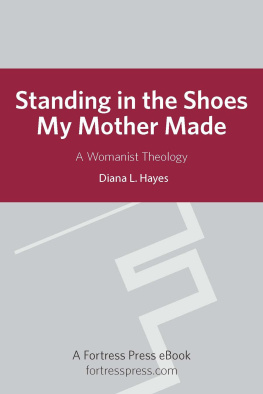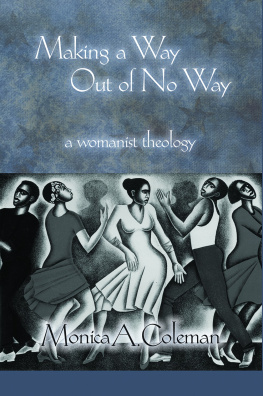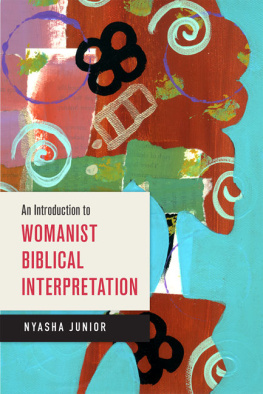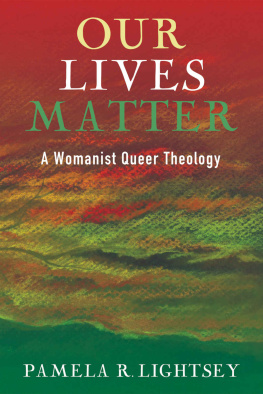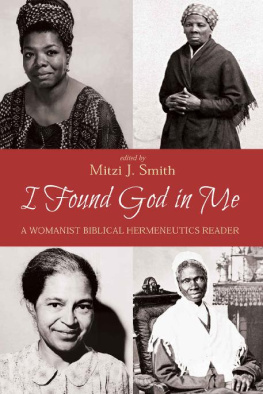2019 by the Board of Trustees
of the University of Illinois
All rights reserved
Library of Congress Cataloging-in-Publication Data
Names: Lemons, Gary L., editor.
Title: Building womanist coalitions: writing and teaching in the spirit of love / edited by Gary L. Lemons.
Description: Urbana: University of Illinois Press, [2019] | Series: Transformations: womanist, feminist, and indigenous studies | Includes bibliographical references and index.
Identifiers: LCCN 2018046036| ISBN 9780252042416 (cloth : alk. paper) | ISBN 9780252084218 (pbk. : alk. paper)
Subjects: LCSH : Feminist theory. | Feminism. | Womens studies.
Classification: LCC HQ 1190 . B 844 2019 | DDC 305.42dc23 LC record available at https://lccn.loc.gov/2018046036
Ebook ISBN 978-0-252-05126-5
Cover illustration: Cover imagery inspired by the painting Hands Raised in Womanist Alliance by Gary L. Lemons, Ph.D.
FOREWORD
Womanism for All! The Transformational Power of Radical Love
What does transformation look like? Whats the relationship between scholarship, research, pedagogy, and innovative social-justice work? How can we use words, ideas, writing, and reading to provoke progressive individual and collective change? How can we enact transformation in the various aspects of our livesin our classrooms, our scholarship, our relationships, our daily practices? Transformations: Womanist, Feminist, and Indigenous Studies has its origins in these and related questions. Grounded in the belief that radical progressive changeon individual, collective, national, transnational, and planetary levelsis urgently needed and in fact possible (although not easy to achieve), Transformations invites authors and readers to transgress the status quo (what Gloria Anzalda refers to as consensus reality) by producing transdisciplinary scholarship informed by women-of-colors theories-praxes and post-oppositional approaches to knowledge and social change.
In Building Womanist Coalitions Gary L. Lemons and his contributors have answered this invitation with bold voices and open hearts. They engage deeply with women-of-colors theories-praxesincluding, but not limited to, Alice Walkers love-saturated womanism; Gloria Anzaldas nepantlera spiritual activism; This Bridge Called My Back s radical self-love and visionary politics; Colonize This! Young Women of Color on Todays Feminism s border-crossing self-definitions; this bridge we call home s transformational identity politics and provocative alliance-making; and the everyday wisdom learned from mothers, sisters, partners, colleagues, educators, and other people in their lives. These engagements demonstrate the profound transformations that women-of-colors wisdom, teachings, and scholarship make when put into dialogue with mainstream academic disciplines. And, like the authors in This Bridge Called My Back and this bridge we call home , Lemons and his contributors remind us that theorizing takes many formsfirst-person autobiographical narrative, poem, dramatic verse, letters, journal entries, and more.
I was first drawn to Lemonss manuscript because his generous interpretation of womanism as a radically inclusive, spirit-inspired, love-infused, liberatory philosophy and worldview closely resembles my own. Lemons defines and enacts womanism in broad, expansive, invitational terms, creating with this edited collection a sanctuary where the Spirit of love for womanism may abide. His sanctuary includes people of many backgrounds, illustrating that womanism is for everyoneregardless of genders, nationalities, racialized identities, religions, sexualities, and so on. Building Womanist Coalitions also embodies womanisms ability to create vibrant, diverse coalitions: As world-citizens, we characterize the essence of a global communitySouth Asian, African (American), Middle-Eastern, Canadian, Caribbean, Latina/Chicana, as well as European. As the contributors demonstrate, womanism is available to anyone willing to open their hearts and minds to its wisdom and ethics. To be sure, given the gender-specific nature of the word womanism, it can seem almost counterintuitive to apply the womanist label to cisgendered men. But as Lemons notes, womanism has enabled him and others to resist masculinist and misogynistic ideas of manhood by lov[ing] ourselves and the womanist within us. Lest you believe that Lemonss decision to embrace womanism was unthinking or overreaching, read his chapter in this volume; walk with him as he wrestles with the sociopolitical implications of identifying with feminism and womanism.
Like feminism and other complex, multifaceted social-justice theories, womanism can be defined in a variety of ways. While all versions honor Spirit (defined broadly) and view black womens wisdom, lives, and words as foundational, they vary considerably in delineating who can or cannot be a womanist, use womanist thought, and create womanist theory. many of his contributors) self-define as both womanists and feminists. Fortunately, because womanism neither homogenizes nor simplifies, womanists dont need to fully agree with each otherat least, according to the version of womanism that I espouse.
In this book series and within the pages of this book, womanism represents a radically inclusive philosophy and daily practice potentially available to anyoneregardless of personal identity categories (e.g., gender, race, ethnicity, class, religion, sexuality, and so forth). This expansive womanism allows space for contradictions to coexist, jostling each other. Indeed, womanism invites contradictions in and assures us that adequate space and time enables the contradictions to mix, nudge, and speak to each other, initiating additional transformations. To borrow Layli Maparyans analogy, womanism functions like a big tent so spacious that it includes all family membersregardless of their disagreements with each other. However, this is not an anything-goes inclusion. Although womanism defines kinship broadly and invites everyone into the tent, it stipulates a few ground rules: the willingness to respect others, to listen with humility, and to remain open to the possibility of being changed by our encounters with others.
I attribute womanisms radical inclusiveness to its affirmative, visionary, sacred worldview.
Everything that exists is shaped by and infused with spirita creative life force known by many names (soul, God, energy, consciousness, thought, and so on). This shared life force ensures our interconnectedness with all existence; whether we acknowledge or ignore it, were all interrelated and kin. Or, rephrased in more conventional western academic terms: radically inclusive versions of womanism are grounded in a paradoxical monism positing a world composed entirely of one highly complex, always-morphing stuffa foundational spirit-matter substance that embodies itself as an infinite variety of forms. Because were all infused with this life-force spirit, we share a commonalitywhat Anzalda describes as a category of identity wider than any social position or racial label ( Light 138). When we acknowledge this shared identity category, were more willing to take risks and work to connect with otherseven ( or especially! ) with those whose lives and experiences differ greatly from our own. Were willing to be radically inclusive.





